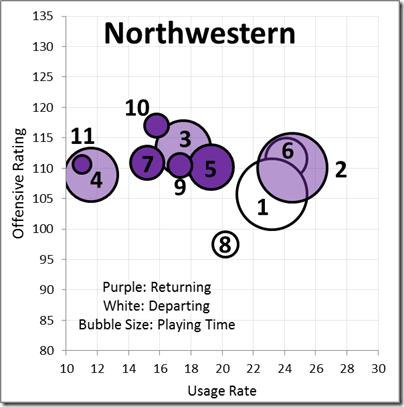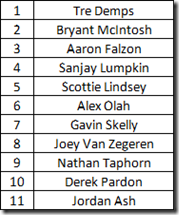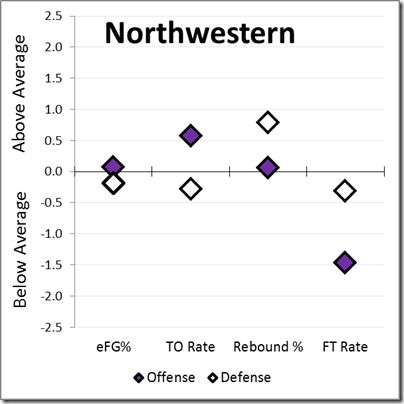Bryant McIntosh [Nuccio DiNuzzo – Chicago Tribune]
PREVIOUSLY: Illinois, Indiana, Iowa, Maryland, Michigan, Michigan St., Minnesota, Nebraska
After thirteen seasons with Bill Carmody at the helm, Northwestern decided to move in a different direction, bringing in Chris Collins – a Duke assistant and son of former NBA coach Doug Collins – to lead the program on its quest for its first ever NCAA Tournament appearance. That drought is the overwhelming narrative of Northwestern basketball; the goal for Collins – or really for any NU coach – is very simple, though quite difficult. As the administration’s patience with Carmody shows, he’ll probably be given plenty of time to get the Cats to the dance before they turn to someone else.
Through three seasons, it’s hard to tell if Collins will be able to get the program there or not. The challenges of coaching at Northwestern are obviously much different than they were at Duke, and even though he’s improved NU’s recruiting and upped the general talent level of the program, they’ve struggled to develop an identity as Collins has had to learn to be a head coach on the fly. Last season, they had an incredibly easy non-conference schedule and went 12-1 (losing only to North Carolina, the national runner-up), but had a losing record in Big Ten play and didn’t even get an NIT bid.
Still, even if the wins came mostly against poor competition, Year Three was a step in the right direction for Collins and the Wildcats: they jumped to 68th in Kenpom’s rankings after finishing outside the Top 100 in the first two seasons of his tenure. Northwestern does lose two key seniors – chucker combo guard Tre Demps and the Great and Powerful big man Alex Olah – but they return their best player, point guard Bryant McIntosh, get Vic Law back from injury, and have a promising class of rising sophomores. At Northwestern, building is slow, but the NIT is a realistic goal for this season.
[More on the Wildcats after the JUMP]
!break>
LAST SEASON
This is one of the stranger usage / efficiency distributions in the Big Ten from this past season; typically, efficiency decreases linearly with increased usage, but for Northwestern, most players were roughly as effective as the rest, regardless of how much they had the ball in their hands.
Collins leaned very heavily on his two guards, playing Bryant McIntosh and Tre Demps roughly 90% of available minutes. They were rather similar in some regards: the shooting splits (2P% / 3P% / FT%) of each were pretty close – 45 / 37 / 82 for McIntosh, 45 / 33 / 66 for Demps – but the biggest difference was in the assist rate, as McIntosh had the 14th-best assist rate nationally. For a sophomore, McIntosh’s offensive rating of 110.1 and usage rate of 24.5 are very encouraging.
Alex Olah dealt with injuries or else he would have played more, but he was a focal point of the NU offense when he was able to play, shooting 56% on two-point attempts. His shot-blocking ability might be missed the most, however; even though his agility was lacking and that made him a liability in pick-and-roll coverage, he was still a great rim protector. Virginia Tech grad transfer Joey Van Zegeren was as well, but his playing time dwindled as the season went on because he couldn’t avoid fouling all the time.
The role players were mostly young. Sanjay Lumpkin is a wallflower on offense, but earns his playing time with defensive effort. Scottie Lindsey showed some good things as a sophomore. Aaron Falzon – a freshman – was pretty much just a shooter and hit 35% of his attempts; Derek Pardon, another freshman, put up great numbers adjusted for his low level of playing time and should start at center this season.
Four Factor Z-Scores from games against Big Ten opponents
Northwestern’s statistical profile was fairly average – in most categories, they finished in the middle third of the conference, although they were unable to get to the free throw line. Their non-conference numbers – and the weakness of that schedule – boosted their overall four factors profile, but the conference-only numbers suggest that they were mediocre overall. Their biggest strengths, rebounding and 2-point defense, will surely be affected by Alex Olah’s departure.
NEWCOMERS
There’s already been some bad news for Northwestern basketball, as the top recruit in the 2016 class – wing Rapolas Ivanauskas – suffered a season-ending shoulder injury that will force him to take a redshirt. Ivanauskas was a fringe Top-150 prospect, as was Illinois big man Barret Benson, who picked Northwestern over reported offers from several Big Ten schools. Benson is a big body at 6’10 and has the game of a traditional back-to-the-basket Big Ten center; he doesn’t play above the rim or have much lateral agility, but because he’s only one of two centers on the roster, he’ll play. The other signee in the 2016 class is point guard Isiah Brown, a prolific high school scorer who was once a Washington commit.
The most important addition to the 2016-17 Wildcat squad will be the return of swingman Vic Law from injury. Law – the most highly-regarded recruit Northwestern has signed in the recruiting service era – will be relied on to play starter minutes at a high level and he’s expected to be NU’s second-best player behind Bryant McIntosh. He had some issues with efficiency as a freshman but demonstrated that he’s clearly a cut above the rest of the Wildcats when it comes to quickness, athleticism, and all-around defensive ability.
PROJECTED ROTATION
- STARTER (POINT GUARD) – Bryant McIntosh (Jr, 6’3, 185): Played a lot as a freshman, took a big step forward as a sophomore, should be one of the Big Ten’s best point guards, great assist rate, solid shooting splits for the amount of shots he took.
- STARTER (GUARD) – Scottie Lindsey (Jr, 6’5, 210): Took over half his shots from three and made 41%, showed good passing skills as a three last season, high foul rate for a guard might limit playing time, though could be less aggressive as a starter.
- STARTER (WING) – Vic Law (R-So, 6’7, 205): Best recruit of the Collins era is coming off of an injury, struggled with efficiency as a freshman but showed positive signs as a defender and rebounder, might have to be the secondary scorer.
- STARTER (WING) – Aaron Falzon (So, 6’8, 215): Took 78% of his shot attempts from three-point range and only hit 35%, but since he was virtually invisible otherwise, his offensive rating was one of the best on the team, started as a freshman.
- STARTER (POST) – Dererk Pardon (So, 6’8, 235): Shot 65% from the field last season but only 53% from the free throw line, offensive rebounding rate of 12.3(!) in a quarter of available minutes, foul rate wasn’t that bad for a freshman big.
- BENCH (POINT GUARD) – Jordan Ash (So, 6’3, 190): Played sparingly behind McIntosh and probably won’t see much PT again, decent assist rate, but turnover-prone, only took 29 FGA last season.
- BENCH (WING) – Nathan Taphorn (Sr, 6’7, 215): Effective outside shooter (40%) took most of his attempts from three, foul prone, blocked some shots, good rebounder, nice piece off the bench.
- BENCH (WING) – Sanjay Lumpkin (R-Sr, 6’6, 220): One of the lowest usage rates in the Big Ten every season, but has garnered playing time because of his individual defense, even though block and steal rates aren’t special.
- BENCH (TRADITIONAL FOUR) – Gavin Skelly (Jr, 6’8, 220): Doesn’t take many shots, but very efficient when he does take them, great block rate, turned it over a ton, got to the free throw line but only okay there (64%).
- BENCH (POST) – Barret Benson (Fr, 6’10, 240): Best attribute is his size, should develop more physically in time, will be counted on to play significant rotation minutes because of the lack of depth at center.
PLAYER COMPARISON
A few years ago, I came up with a system that would compare the statistical profiles of Big Ten players to their historical counterparts by taking the sum of the differences between a given player’s profile and each of the thousand player-seasons from 2008-present in twenty different statistical categories.
# value is the Z-Score of the player’s statistic (or statistics averaged over multiple seasons) relative to the entire sample
Perhaps the most underrated player in the Big Ten, Bryant McIntosh turned in a sophomore season that suggests he’ll be among Northwestern’s best players ever if he keeps up his current development trajectory. He wasn’t named to the watch list of college basketball’s “best point guard” award, and was probably the most notable omission – if he builds on a great sophomore year, he should be on an All-Big Ten team. Most impressive was his ability to set up his offensively-challenged teammates with good looks and post the second-best assist rate in the Big Ten behind superstar Denzel Valentine of Michigan State.
Demetri McCamey is an interesting comparison for McIntosh; the former Illinois point guard was the best player on some average teams and three of his player-seasons register in McIntosh’s Top 15 most similar. That McIntosh was slightly more efficient speaks well to his ability. Melo Trimble and (especially) Trey Burke are better players, but it’s a positive sign that such outstanding Big Ten point guards register highly on this list.
OUTLOOK
Last season, Chris Collins clearly set up his non-conference schedule to get into the NIT and it didn’t work; this time around, Northwestern should improve enough to make a postseason appearance a reality – though this team still seems a ways away from NCAA Tournament contention. It’s still a young team: there probably won’t be any senior starters, so the 2017-18 season might be a realistic target for that elusive first tournament bid.
What’s clear is that Northwestern has increased the general talent level and even if Collins can’t coach them up to their full potential, the baseline is higher than it was during most seasons of the Carmody era. Bryant McIntosh is a legitimately good player and should be able to elevate the play of most of his teammates with his superb passing ability; several players on the team have surprisingly high block and steal rates (indicating athleticism and defensive ability); there are quite a few promising sophomores that could have a breakout year similar to what McIntosh was able to do last season.
Still, it’s Northwestern. Even if things look decent enough on paper, there’s little reason to believe that this team will be a legitimate threat to finish in the top half of the conference and finally make that breakthrough into the NCAA Tournament. Chris Collins was a completely different type of coach than Carmody and might be able to take them there in time, but he’s still learning on the job and Northwestern’s had strategic inconsistency from year-to-year in his tenure. It remains to be seen if he can establish a concrete identity of some kind. Until that happens, they might be stuck in the same spot Carmody topped out at.





